Does your kitchen make the grade?
September 9, 2010
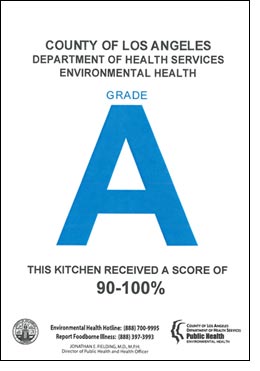 Friends say you cook like a top chef. Now find out whether your home kitchen earns an “A” for restaurant-level cleanliness standards, too.
Friends say you cook like a top chef. Now find out whether your home kitchen earns an “A” for restaurant-level cleanliness standards, too.
Using the A, B, C grading system similar to the one posted in restaurant windows, the county’s Department of Public Health lets you take an online “Home Kitchen Self-Inspection” and then scores the test to show where your kitchen’s standards are high—or not.
After submitting the test, you’ll get a letter and number grade, along with suggestions on how to correct any “violations.”
The test is intended to increase your understanding of day to day food safety issues, especially areas you may have long overlooked.
The 44 mostly yes-or-no questions range from super-basic (“My refrigerator is working properly”) to the tougher (“I wash and sanitize my sponge daily and replace it routinely when soiled.”) The test questions aren’t exactly the ones food inspectors use to grade restaurants, but they are adapted from the same state Health and Safety Code regulations.
Before the quiz, you’re required to answer several personal questions, such as your city, age range and gender. You’re also asked a series of questions that the department’s director, Dr. Jonathan Fielding, says are designed to “help us enhance our domestic food safety outreach efforts.”
If you score 90 percent or better, the public health department will mail you an “A” grade inspection card to display proudly in your kitchen.
And, in case you don’t feel like cooking tonight, here’s the department’s grading list for retail establishments.
Posted 9-8-10
Deadline nears for new Valley COG job
September 9, 2010
The newly created San Fernando Valley Council of Governments is seeking proposals from individuals or consultancies to become the group’s first executive director, managing and directing its business affairs. The deadline for proposals for the part-time post is Wednesday, September 15.
The San Fernando Valley COG, created in May, is a Joint Powers Authority that brings together under one roof five Valley area cities—Burbank, Glendale, San Fernando, Los Angeles and Santa Clarita—as well as county unincorporated areas. Other cities may join in the future.
The new coalition is seeking to create more regional identity and clout among the municipalities that represent the area’s 2 million residents. Its board is comprised of representatives from each city and the two L.A. County supervisorial districts that represent the Valley. Supervisor Zev Yaroslavsky was named board chairman. The board will attempt to forge regional consensus on issues such as economic development and transportation.
The executive director would work with the board to develop programs and priorities, seek grants and other revenue and act as a liaison for the group with outside governments and agencies. The COG budget includes about $48,000 for the Executive Director position. Details about the duties and opportunities of the position are specified in the request for proposals, which can be viewed here.
Posted 9-8-10
An L.A. beachcomber heads south
September 7, 2010
Los Angeles County’s sandprint will soon be showing up on oily Gulf Coast beaches.
At the urgent request of BP, the county’s Department of Beaches & Harbors is finalizing a deal to send a BeachTech 2000 to Mississippi to help in the cleanup of the Gulf oil spill. The two-ton “sanitizer” ordinarily rakes and sifts cans, bottles and cigarette butts from county beaches near Redondo. Now it will see action sifting tar balls from barrier island beaches blackened by the giant oil disaster.
“We thought it was a great opportunity for the county to get involved and assist in the clean up,” said Ken Foreman, assistant chief of facilities and maintenance for Beaches & Harbors.
In exchange for the three-year-old unit, BP will buy the county a new replacement, valued at about $50,000. The Board of Supervisors unanimously approved a motion by Supervisor Don Knabe at Tuesday’s meeting to seal the deal. The new unit should arrive next month.
The unusual trade came because BeachTech couldn’t supply the sanitizers quickly enough for BP, explained Scott Merrill, manager of BeachTech’s North American operations.
BeachTech’s models work particularly well because, unlike other beach groomers, their rakes can be removed and sand can be sifted exclusively through a screen, Merrill said. Raking breaks up the globules of oil, making cleanup more difficult.
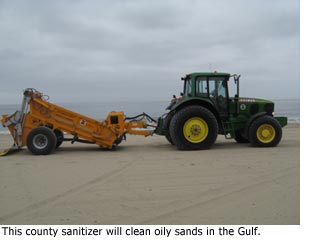 Earlier this summer BP bought 25 BeachTech sanitizers after federal and state environmental officials determined that the equipment was effective. By late August, BP wanted 10 more, but BeachTech didn’t have the inventory to fill the whole order.
Earlier this summer BP bought 25 BeachTech sanitizers after federal and state environmental officials determined that the equipment was effective. By late August, BP wanted 10 more, but BeachTech didn’t have the inventory to fill the whole order.
Widely criticized for not reacting to the disaster swiftly enough, BP did not want to wait and asked BeachTech to call its best customers for loaners in perfect working condition.
“They said, ‘We don’t want cash for clunkers’,” Merrill said.
Besides L.A. County, four municipalities (three in Florida and one in Alabama) also agreed to send equipment. Clean up crews are using the equipment mostly at night and in the cool early morning hours, when the oily gunk is coolest, hardest and easiest to handle.
L.A. County’s yellow unit will be loaded on a truck later this week, most likely bound for unpopulated barrier islands off the Mississippi coast, where the beach cleanup is just getting underway. Foreman said that until L.A.’s new unit arrives, beach-cleaning crews will use other equipment.
“We should be okay for the time being,” Foreman said. “We didn’t want to miss the opportunity to help.”
Posted 9-7-10
“Waiting for Lefty” comes to Theatre West
September 2, 2010
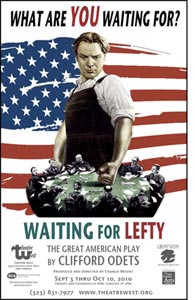 As part of its “Chestnuts” series of American drama revivals, Theatre West fittingly chose Labor Day weekend to open its new production of “Waiting for Lefty,” Clifford Odets’ classic 1935 drama about the passions and conflicts unleashed as New York cab drivers plan a labor strike. Odets based the story on an actual strike by cabbies the previous year.
As part of its “Chestnuts” series of American drama revivals, Theatre West fittingly chose Labor Day weekend to open its new production of “Waiting for Lefty,” Clifford Odets’ classic 1935 drama about the passions and conflicts unleashed as New York cab drivers plan a labor strike. Odets based the story on an actual strike by cabbies the previous year.
The run extends from opening night on Sept. 3 through October 10, with Friday and Saturday evening performances at 8 pm and Sunday matinees at 2 pm.
Theatre West is located at 3333 Cahuenga Blvd West, between Barham and Lankershim, just down the block from Universal Studios. Park free across the street at the Credit Union – or use the Metro Trip Planner and take the Red Line subway to the Universal City Station.
Buy your tickets online, and call (323) 851-7977 for further information.
County crackdown on numbers racket
September 2, 2010
Identity thieves, meet Kai Ponte.
Ponte is overseeing an unprecedented technological effort by Los Angeles County to conceal Social Security numbers on millions of documents filed with the Registrar-Recorder/County Clerk during the past 30 years.
The project, mandated by California law, is aimed at protecting consumers by depriving crooks of information they can use to steal identities and inflict havoc on the lives of their victims. Social Security numbers—once routinely included on many kinds of official documents—are highly prized in this world of high-tech theft.
Ponte, who supervises the management systems team in the recorder’s office, understands the stakes and offers this warning to the growing legions of rip-off artists: “Go look somewhere else because you’re not going to find anything here.”
The state law, which went into effect last year, was authored by Assemblyman Dave Jones of Sacramento, a longtime advocate of consumer privacy legislation. To make his point on the need for this one, he initiated a public records search of some of the elite of Sacramento’s business community.
“We pulled up a wealth of information, including their Social Security numbers, which experts repeatedly told us was the most important piece of information to have if you wanted to steal someone’s identity,” Jones says. “We didn’t name names because we didn’t want to have a race to the recorder’s office by identity thieves, but we did mention the people by category—a CEO, a prominent developer, a banker.”
No one, of course, could have predicted decades ago, long before the Web revolution, that the millions of documents being filed with counties could some day become gold-plated invitations for criminality. Dean Logan, Los Angeles County’s Registrar-Recorder/County Clerk, says the redaction project was crucial in making records of the past safe for an age in which so much personal information is accessible through online databases. Although the law covers documents dating back to 1980, Los Angeles County is beginning with 1977.
“What we’re doing is balancing the purpose of maintaining a public record while eliminating the risk that it can be used to steal somebody’s identity,” Logan says, adding that, for the most part, complete Social Security numbers no longer appear on documents filed with the recorder’s office.
Under the new law, every county recorder is required to keep an unaltered “official record” and a “public record” that masks the first five digits of a person’s Social Security number.
“Most counties thought, ‘We’ll just make two copies,’ ” Ponte says. That’s an easy fix for a county like Modoc, which handled only 3,286 documents last year, Ponte says. “But in L.A. County we do between 2 million to 3 million annually, so we certainly didn’t want to create two copies.”
To that end, Los Angeles County launched the most technologically sophisticated strategy in the state to conceal Social Security numbers—a strategy that got a boost this week when the Board of Supervisors approved a key contract worth potentially as much as $821,370. Under that contract, Neubus Inc. will make digital copies of 20 million pre-1992 documents that now exist only on microfilm.
This digital conversion is essential to L.A. County’s unique approach. Instead of making a duplicate set of records like other counties, officials here will use software that searches documents for Social Security numbers and then automatically masks them before the record is viewed by the public. The old microfilmed documents can’t be altered unless they’re converted into digital files. The 50 million documents filed since 1992 already are digitized.
In all, Ponte estimates that of the tens of millions of documents that will be scanned, about 10 percent of them will have Social Security numbers that need to be masked. Virtually all these documents are related to property transactions of various sorts. Registrar-Recorder officials estimate that the project could take up to five years to complete.
As for the program’s cost, it’s being covered by a fund created through the state law and fed by a $1.00 fee the county collects on each recorded real property document. In other words, says registrar-recorder Logan, “we’re not taking something away from the general fund at a time of fiscal crisis.”
Logan also noted that, given the bad rap that public officials sometimes deservedly earn, projects like this one—designed entirely with the public’s protection in mind—“should make people feel good about their government.”
Posted 9/2/10
Movie magic, Metro-style
September 2, 2010
Don’t look now, but a miniature multiplex has set up shop in your computer. It’s got something for everybody: romantic comedy, travel/adventure, coming of age, urban documentary. You’ll laugh, you’ll cry, you might even forget about YouTube for a few minutes. Because these are micro-movies with a mission. The shorts, none longer than 2 minutes, are the finalists in the Metropolitan Transportation Authority’s Transit Flicks Video Contest. Each was selected for “originality, believability and how well they convince others to try transit.” Now it’s your turn to pick the best of the lot. Watch the movies and cast your ballot here before midnight on Tuesday, Sept. 7.
The grand prize winner gets a free EZ pass for a year…and, who knows, maybe a shot at Tinseltown immortality. Or at least bragging rights on the morning Metro Rail commute.
Posted 9/02/10
Battle of the bags isn’t over
September 1, 2010
In the end, a ban wasn’t in the bag.
Hopes of outlawing throwaway plastic shopping bags throughout California went bust Tuesday night when the state Senate soundly defeated AB 1998 after passionate floor debate in the waning minutes of the legislative session.
But the fight now moves from Sacramento to the local front, where municipalities including Los Angeles County are poised to jump into the fray.
Los Angeles County Supervisors Zev Yaroslavsky and Mark Ridley-Thomas say they will push for a bag ban here. If the measure is approved by their colleagues on the Board of Supervisors, it could become a model for other local governments seeking to say no to disposable plastic bags.
“I think Los Angeles County, along with a number of other cities and counties around the state—including the city of Los Angeles, and the city of Pasadena, and the city of Santa Monica among others—will pass their own plastic bag ban,” Yaroslavsky told a KPCC radio audience Tuesday.
In taking up the fight, the county would be entering a big money, big media battleground in which both sides are fighting to influence business and consumer behavior in a big way. Opponents of the statewide ban, led by the American Chemistry Council, reportedly spent millions of dollars on lobbyists, a website called Stopthebagpolice.com, and radio and TV ads blasting the bill as a “$1 billion tax” on California consumers. The bill’s supporters spoke out in editorials and a tongue-in-cheek faux-nature video from Heal the Bay called “The Majestic Plastic Bag,” narrated by actor Jeremy Irons.
Proponents of the ban say it is long overdue. Overall, county residents consume about 6 billion bags a year, about 600 per person, according to a county report. The bags clog landfills, produce widespread litter and present an environmental hazard in the oceans as marine animals swallow or get tangled in the billowy plastic.
The state bill, sponsored by Assemblywoman Julia Brownley of Santa Monica, would have banned single use plastic bags at supermarkets, drugstores and convenience stores. Consumers would have been required to bring their own bags or to pay for paper bags at cost. Taxpayers pay an estimated $25 million each year just to put used plastic bags in landfills, Brownley pointed out in support of the bill.
In Los Angeles County, the Public Works Department already is working on a potential bag ban ordinance to be presented to supervisors in October, although key provisions have not been finalized, said Coby Skye, program manager of the Single-Use Bag Reduction and Recycling Program at the Department of Public Works.
A county ban would apply only to unincorporated areas, where 1.3 million county residents live.
Supervisors have been tangling with the bags since 2007, when they passed a motion directing DPW to produce a plan to reduce the use of the bags. In 2008, the county adopted a voluntary bag reduction and recycling program that was backed by the plastics industry. The program laid out benchmarks for compliance which have not been met, thus triggering the development of a potential ban.
San Francisco passed the state’s first ban in 2007. Bans enacted after that in cities including Oakland, Manhattan Beach and Santa Monica have been blocked in court by opponents who demanded and won costly environmental impact reviews. Los Angeles County is completing an environmental impact report that the county could use to defend a ban if one is enacted here. A draft (available here) concludes that, despite the claims of opponents, a ban would produce no significant direct negative environmental impacts.
In Malibu, the county’s only city with a working ban, having plastic bag-free checkout lanes has proven popular.
Rebecca Nelson, senior office assistant in the city’s Environmental Programs department, said grocery stores and drug stores have done a good job complying with the 2008 ordinance. Restaurants have been more of a challenge, with some establishments reverting to old ways. (AB 1998’s provisions would not have covered restaurants.)
“A few sneaky managers have gone to plastic and we have caught them in our annual inspection,” Nelson said.
Bringing a reusable bag to the market is not a big stretch for residents of the celebrity-studded community where environmental friendliness is as much a part of the local lifestyle as going out for sushi at Nobu. But visitors may bring a different set of expectations for how their groceries or takeout orders should be packaged.
“Sometimes we get tourists in here and they’re shocked—or they don’t understand,” said Emily Simon, manager of Malibu Kitchen, located in the Malibu Country Mart.
But for those who live in Malibu, Simon said, the bottom line is: “No one wants to see plastic floating around on the beach here.”
Posted 9/1/10
A farewell to lawns
September 1, 2010
Earlier this year, the Long Beach Water Department started a program to encourage its residents to destroy their grass lawns. It wasn’t part of some vast government plot against green thumbs. Instead, the agency was hoping to persuade folks to go green by growing a different kind of green out in the yard. And the city was willing to spread around some greenbacks–$1 for every square foot of grass replaced with sustainable landscape or “hardscape” such as brick or tile—to get people to take the plunge into conservation-friendly landscaping.
Turns out they didn’t need much persuading. Within an hour of the application process opening in April, Long Beach had received 120 project requests—enough to completely wipe out the $250,000 initially budgeted for the program. The agency now has expanded the funding to $360,000 to meet the demands of everyone on the waiting list, and expects to save 40 million gallons of water over the next ten years.
Similar programs have been offered from Las Vegas to the Los Angeles Department of Water and Power, and now customers of the Los Angeles County Waterworks Districts are getting a chance to join the break-up-with-your-lawn movement, too.
The Cash for Grass program (it’s nothing illicit, just kind of a “Cash for Clunkers” project aimed at your old sod instead your old Saab) will provide cash rebates of $1 per square foot to those who replace their water-guzzling grass lawns with water-efficient landscaping. One can expect to save 55 gallons of water per year for every square foot of grass replaced. Information on the program is here, along with an application to print out.
The county Waterworks program began on August 20th and is slated to end on January 31, 2011, or until the $250,000 allotted for the program runs out. All Waterworks customers, in communities including Malibu, Marina del Rey, Topanga, Acton, Val Verde, Kagel Canyon and the Antelope Valley, are eligible to take part.
But think twice about delaying, given the program’s success in Long Beach.
Even Matthew Lyons, director of planning & water conservation for the Long Beach Water Department, was surprised at what he calls the “overwhelming response” to the Lawn to Garden Incentive Program in his city.
Replacing lawn with drought-tolerant plants doesn’t just save money; it also sets up a whole new way of keeping up with the Joneses, as these Long Beach lawn makeovers make clear. (And drought-tolerant doesn’t necessarily mean drab, as these plants colorfully demonstrate.) Most of all, the no-lawn movement acknowledges the reality of scarce water resources in the region.
“Getting rid of grass lawns is important for Southern California as we look into the future,” Lyons said, “because the fact is that in 20 years if people still keep their grass lawns, there won’t be water.”
Posted 9/1/10




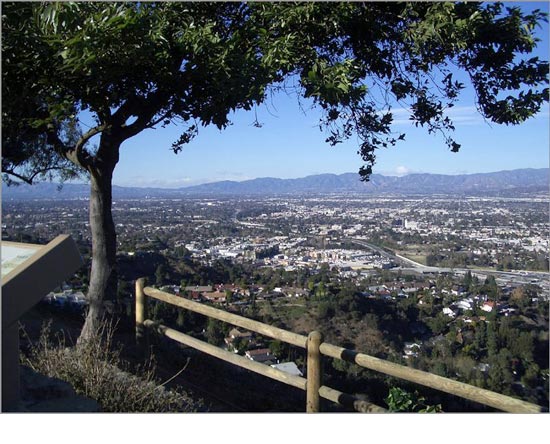

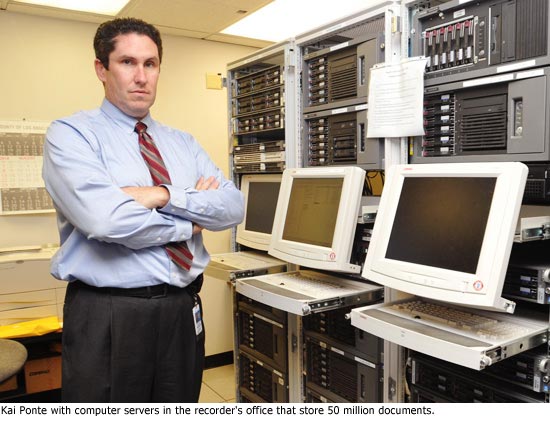
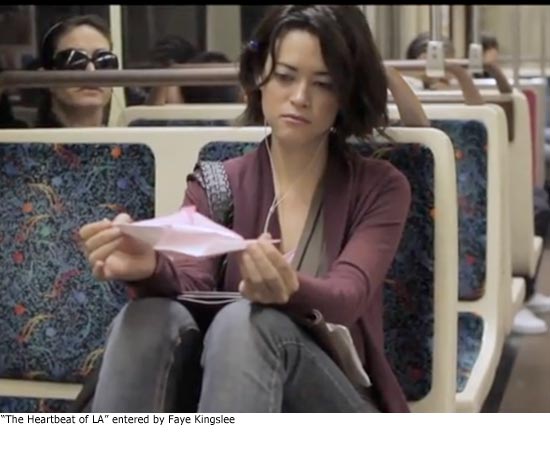
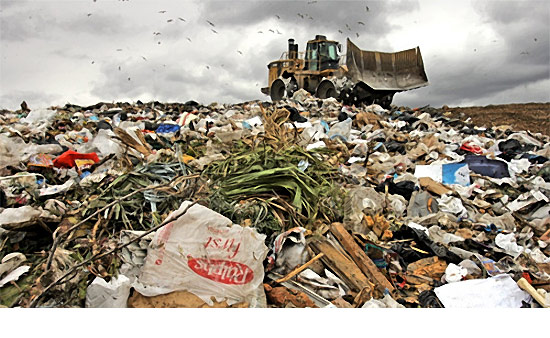






 Check for the latest closure information
Check for the latest closure information








